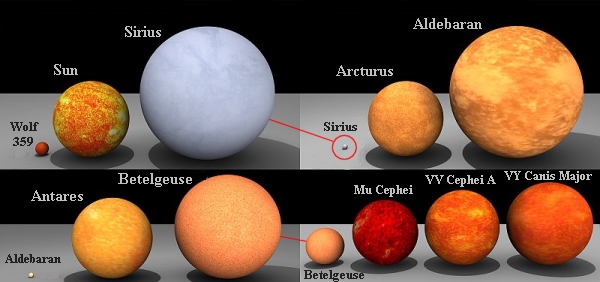Stars are massive balls of hot gas (mostly hydrogen and helium) and generate light and heat using nuclear fusion. They range from about 10,000 km (white dwarfs) to supergiant stars which are over a billion km in diameter. The sun, for comparison, is Approximately 700000 km across.
Birth of stars: After the big bang released all matter and energy into the universe, stars began to form. Stars are formed from clouds which have high concentrations of gas and other matter. These clouds are also known as a nebula. Nebula can be millions of light years in diameter and clump matter together, slowly becoming denser and the birthplace of stars.
Lifespan: In general, the larger the star, the shorter its lifespan. Most massive stars live for about 10 billion years. Our sun is 4.5 billion years old has most likely another 5 billion years of life left. Some of the smallest red dwarf stars are believed to survive for 10 trillion years (although this cannot be tested since the universe is only 13.82 billion years old)Some supergiant stars have very short lifespans ranging from a few hundred thousand years to 30 million years.
Death: At the end of a star’s life, they die; Most normal sized stars (our sun included) will expand into a larger red giant at the end of their lifespan, after using up all of their hydrogen. When our sun does this, it will swallow up mercury and venus as it expands. After it expands, it collapses into an extremely small, yet very dense white dwarf. Over time that white dwarf cools and dims (Earth-sized).
Supernovas: After massive stars run out of hydrogen and expand, they continue to complete nuclear fusion with more massive elements. The star cannot support itself with this fusion and explodes in dramatic fashion, shooting elements across the universe. Supernovas outshine stars and are the brightest thing in the sky for a couple weeks and then darken. Beatlegeuse is an example in our sky, where a supernova will occur soon. After a supernova explosion, all that is left of the past star is a very massive center. That can either result in a neutron star or a black hole depending on the mass of the initial star.
Neutron stars are about the size of a city and rotate very fast – multiple times a second. We can detect the rotation from the magnetic poles of the stars, and with telescopes, can “hear” the pulse of the star. They are therefore called pulsars.
Black Holes: When more massive stars supernova, they become black holes. They are super massive and dense spheres that are so massive that even light cannot escape its gravitational pull. Black holes can be tiny, or also massive; it is thought that there is a black hole at the center of each galaxy, which the rest of the galaxy orbits.
